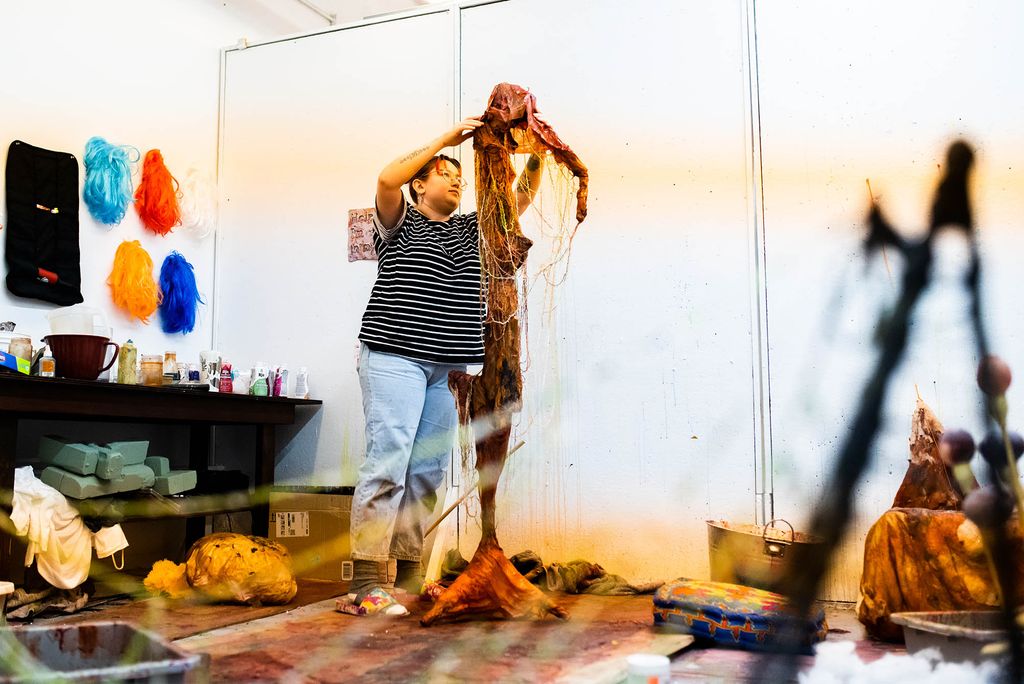How I Made This: Maithili Rajput (CFA’25)
Maithili, an MFA sculpture student, is creating an ornate, human-sized contraption for her thesis project. Part of her final exhibition will include a 24-hour video of herself rotating inside it.

How I Made This: Maithili Rajput (CFA’25)
Maithili, a student in BU School of Visual Arts’ graduate sculpture program, is creating an ornate, human-sized contraption for her thesis project. Part of her final exhibition will include a 24-hour video of herself rotating inside it.
This article was originally published in BU Today on March 5, 2025. Series by Sophie Yarin. Photos by Cydney Scott
How I Made This is a series from BU Today that explores how Boston University students create their works of art—be it a musical composition, a fiber sculpture, a short story, a painting, and beyond.
EXCERPT
For sculpture major Maithili Rajput, graduate thesis season marks her first time using colored pigments in a sculpture and her first time showing video-based performance art in a white-wall gallery. All are factors in her thesis project, which combines elements of sculpture, videography, and installation art.
For her final artistic challenge at Boston University, Rajput (CFA’25) is creating a rotating platform she’ll use in a video performance—incorporating her body itself into the sculpture. She plans to balance atop the platform, enclosed in an ornate column, and film herself going round and round as the device rotates for a full 24 hours. The sculpture, and the accompanying video, will be on view at the Faye G., Jo, and James Stone Gallery for BU School of Visual Arts‘ annual end-of-year MFA Thesis Exhibition.
“I’ve been thinking about the human body as a material,” Rajput says. “How can I push it to its limit? How can I use my body as a part of my sculpture?”
“HOW I MADE THIS”
BU Today: Can you tell us a little bit about the video element of your thesis?
Maithili Rajput: It’s very exciting, because I am planning to do a 24-hour performance. I was like, I can at least do 24 hours before I graduate, and I’m already pretty good at not sleeping at night. The camera is just going to be focused on my face, and it’s going to capture it every 15 seconds or so—each rotation. The video will show my facial expression and how it changes over 24 hours, but the audience can’t fully see what’s happening—they can only get a glance of my expression. It’s going to be this very absurd and cryptic video that’s about testing the human body’s limitations and documenting how it changes over time, which captures the absurdity of daily life in a 24-hour timeline.
BU Today: What’s the significance of the rotating platform?
I keep coming back to this idea that discomfort isn’t just something to suffer through; it’s where something real happens. I’m drawn to endurance, not as a victory or a failure, but as a state of being. The body against space, against objects, against expectation. Especially as a woman, just existing in certain spaces can feel like an act of resistance. My work exists in that friction, where strength and vulnerability blur, and where the struggle isn’t just about pain, but about time, weight, and presence.



VISUAL ARTS THESIS EXHIBITIONS
Every Spring, Boston University School of Visual Arts hosts group exhibitions showcasing the work of graduating students in the undergraduate and graduate programs.
Thesis Exhibitions typically are held on campus in the BU Art Galleries at the College of Fine Arts, including the Faye G., Jo, and James Stone Gallery, 808 Gallery, and Commonwealth Gallery, with satellite shows throughout the School of Visual Arts facilities.